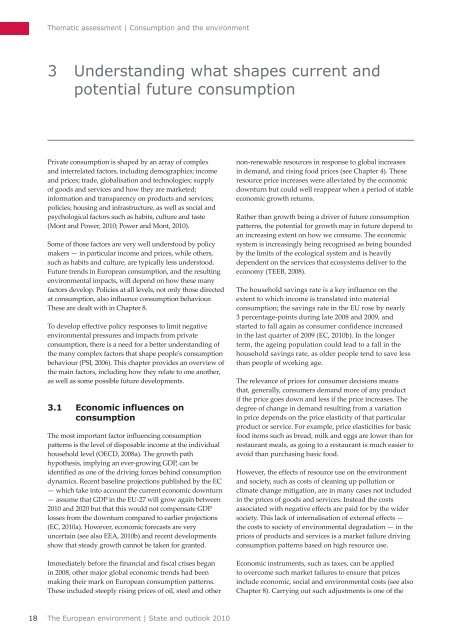Consumption and the environment (SOER2010) - European ...
Consumption and the environment (SOER2010) - European ...
Consumption and the environment (SOER2010) - European ...
You also want an ePaper? Increase the reach of your titles
YUMPU automatically turns print PDFs into web optimized ePapers that Google loves.
Thematic assessment | <strong>Consumption</strong> <strong>and</strong> <strong>the</strong> <strong>environment</strong><br />
3 Underst<strong>and</strong>ing what shapes current <strong>and</strong><br />
potential future consumption<br />
Private consumption is shaped by an array of complex<br />
<strong>and</strong> interrelated factors, including demographics; income<br />
<strong>and</strong> prices; trade, globalisation <strong>and</strong> technologies; supply<br />
of goods <strong>and</strong> services <strong>and</strong> how <strong>the</strong>y are marketed;<br />
information <strong>and</strong> transparency on products <strong>and</strong> services;<br />
policies; housing <strong>and</strong> infrastructure, as well as social <strong>and</strong><br />
psychological factors such as habits, culture <strong>and</strong> taste<br />
(Mont <strong>and</strong> Power, 2010; Power <strong>and</strong> Mont, 2010).<br />
Some of those factors are very well understood by policy<br />
makers — in particular income <strong>and</strong> prices, while o<strong>the</strong>rs,<br />
such as habits <strong>and</strong> culture, are typically less understood.<br />
Future trends in <strong>European</strong> consumption, <strong>and</strong> <strong>the</strong> resulting<br />
<strong>environment</strong>al impacts, will depend on how <strong>the</strong>se many<br />
factors develop. Policies at all levels, not only those directed<br />
at consumption, also influence consumption behaviour.<br />
These are dealt with in Chapter 8.<br />
To develop effective policy responses to limit negative<br />
<strong>environment</strong>al pressures <strong>and</strong> impacts from private<br />
consumption, <strong>the</strong>re is a need for a better underst<strong>and</strong>ing of<br />
<strong>the</strong> many complex factors that shape people's consumption<br />
behaviour (PSI, 2006). This chapter provides an overview of<br />
<strong>the</strong> main factors, including how <strong>the</strong>y relate to one ano<strong>the</strong>r,<br />
as well as some possible future developments.<br />
3.1 Economic influences on<br />
consumption<br />
The most important factor influencing consumption<br />
patterns is <strong>the</strong> level of disposable income at <strong>the</strong> individual<br />
household level (OECD, 2008a). The growth path<br />
hypo<strong>the</strong>sis, implying an ever-growing GDP, can be<br />
identified as one of <strong>the</strong> driving forces behind consumption<br />
dynamics. Recent baseline projections published by <strong>the</strong> EC<br />
— which take into account <strong>the</strong> current economic downturn<br />
— assume that GDP in <strong>the</strong> EU‐27 will grow again between<br />
2010 <strong>and</strong> 2020 but that this would not compensate GDP<br />
losses from <strong>the</strong> downturn compared to earlier projections<br />
(EC, 2010a). However, economic forecasts are very<br />
uncertain (see also EEA, 2010b) <strong>and</strong> recent developments<br />
show that steady growth cannot be taken for granted.<br />
Immediately before <strong>the</strong> financial <strong>and</strong> fiscal crises began<br />
in 2008, o<strong>the</strong>r major global economic trends had been<br />
making <strong>the</strong>ir mark on <strong>European</strong> consumption patterns.<br />
These included steeply rising prices of oil, steel <strong>and</strong> o<strong>the</strong>r<br />
non‐renewable resources in response to global increases<br />
in dem<strong>and</strong>, <strong>and</strong> rising food prices (see Chapter 4). These<br />
resource price increases were alleviated by <strong>the</strong> economic<br />
downturn but could well reappear when a period of stable<br />
economic growth returns.<br />
Ra<strong>the</strong>r than growth being a driver of future consumption<br />
patterns, <strong>the</strong> potential for growth may in future depend to<br />
an increasing extent on how we consume. The economic<br />
system is increasingly being recognised as being bounded<br />
by <strong>the</strong> limits of <strong>the</strong> ecological system <strong>and</strong> is heavily<br />
dependent on <strong>the</strong> services that ecosystems deliver to <strong>the</strong><br />
economy (TEEB, 2008).<br />
The household savings rate is a key influence on <strong>the</strong><br />
extent to which income is translated into material<br />
consumption; <strong>the</strong> savings rate in <strong>the</strong> EU rose by nearly<br />
3 percentage‐points during late 2008 <strong>and</strong> 2009, <strong>and</strong><br />
started to fall again as consumer confidence increased<br />
in <strong>the</strong> last quarter of 2009 (EC, 2010b). In <strong>the</strong> longer<br />
term, <strong>the</strong> ageing population could lead to a fall in <strong>the</strong><br />
household savings rate, as older people tend to save less<br />
than people of working age.<br />
The relevance of prices for consumer decisions means<br />
that, generally, consumers dem<strong>and</strong> more of any product<br />
if <strong>the</strong> price goes down <strong>and</strong> less if <strong>the</strong> price increases. The<br />
degree of change in dem<strong>and</strong> resulting from a variation<br />
in price depends on <strong>the</strong> price elasticity of that particular<br />
product or service. For example, price elasticities for basic<br />
food items such as bread, milk <strong>and</strong> eggs are lower than for<br />
restaurant meals, as going to a restaurant is much easier to<br />
avoid than purchasing basic food.<br />
However, <strong>the</strong> effects of resource use on <strong>the</strong> <strong>environment</strong><br />
<strong>and</strong> society, such as costs of cleaning up pollution or<br />
climate change mitigation, are in many cases not included<br />
in <strong>the</strong> prices of goods <strong>and</strong> services. Instead <strong>the</strong> costs<br />
associated with negative effects are paid for by <strong>the</strong> wider<br />
society. This lack of internalisation of external effects —<br />
<strong>the</strong> costs to society of <strong>environment</strong>al degradation — in <strong>the</strong><br />
prices of products <strong>and</strong> services is a market failure driving<br />
consumption patterns based on high resource use.<br />
Economic instruments, such as taxes, can be applied<br />
to overcome such market failures to ensure that prices<br />
include economic, social <strong>and</strong> <strong>environment</strong>al costs (see also<br />
Chapter 8). Carrying out such adjustments is one of <strong>the</strong><br />
18<br />
The <strong>European</strong> <strong>environment</strong> | State <strong>and</strong> outlook 2010








